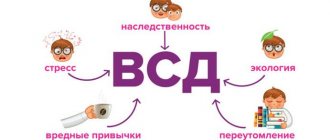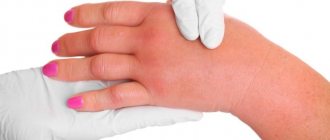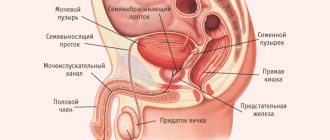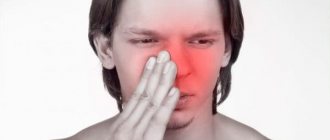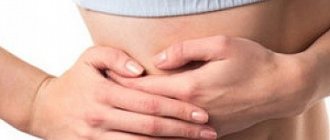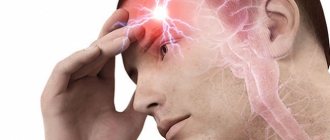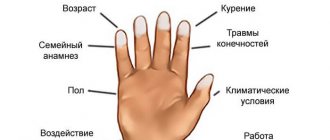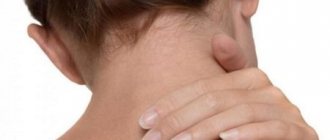Author of the article: Victoria Stoyanova, category 2 doctor, head of the laboratory at the diagnostic and treatment center (2015–2016).
Article publication date: 07/27/2016
Article updated date: 01/28/2020
Pain in the right shoulder can occur for various reasons: inflammation of the tendons, arthritis of various origins, arthrosis, painful “lumbago” due to osteochondrosis of the cervical spine, etc.
The nature of the lesion in the right shoulder, its course, symptoms and treatment are the same as in the case of pathology of the left joint. But since most people are right-handed, for the same reasons the right shoulder joint is more often affected - after all, it experiences maximum stress during physical activity, during manual work, and when playing certain sports (for example, tennis).
The severity of a patient's complaints when a joint is damaged can vary: from minor, transient pain to excruciating pain syndrome, which is accompanied by loss of joint function. The severity of the condition depends on the disease, the degree of its development, the adequacy of the treatment (or lack thereof). For example, with arthrosis at the initial stage, the symptoms are mild, the function of the joint suffers slightly, but with infectious arthritis, acute pain, fever and swelling of the shoulder occur.
The prognosis for pain in the right shoulder most depends on the timeliness of treatment: the earlier therapy is started, the greater the likelihood of maintaining range of motion in the arm or achieving a complete recovery. In general, pain in the right shoulder can be successfully treated, but the treatment process, its complexity and results all depend on the specific disease.
If shoulder pain occurs, you should immediately consult a doctor (orthopedic traumatologist, arthrologist, or first a therapist), who will find out the cause and prescribe the optimal treatment.
Important! According to anatomy, the shoulder is the arm from the shoulder joint to the elbow; pain in this area is observed in a number of diseases of internal organs: cholecystitis, pancreatitis, angina pectoris. In this article, I proceed from the more “folk” concept that the shoulder is the shoulder joint.
Further in the article: the main reasons why pain occurs in the right shoulder (possible pathologies), diagnosis and treatment methods.
Diagnostics
It is up to the doctor to determine exactly why the right shoulder hurts. An experienced specialist will be able to suggest a diagnosis based on complaints and examination, and radiography helps confirm it. Additionally, computed tomography, ultrasound of the joint, and blood tests (general and biochemical tests) are performed.
Symptoms
Speaking about the general clinical picture, it is necessary to highlight the following possible additional signs:
- pain in the shoulder and neck may increase when you raise your arm;
- minimal physical activity or activity causes discomfort;
- pain can be paroxysmal and vary in intensity and nature of manifestation.
You need to understand that shoulder pain, if it is not a specific injury, is almost always accompanied by symptoms characteristic of the underlying cause.
For pathologies that affect joints, the general clinical picture may be supplemented by the following signs:
- the patient is almost constantly tormented by aching pain in the back, which subside only in a state of complete rest;
- the arm periodically goes numb, but the person can perform physical activity;
- Shoulder hurts when raising your arm, sometimes radiating to the back or arm;
- local increase in temperature, feeling as if something hot was applied to the shoulder;
- at chronic stages of development, pain in the right or left shoulder is already permanent.
In some cases and depending on the underlying factor, shoulder deformity may be observed on the left or right, depending on the location of the development of the disorder.
If pain in the left or right shoulder is caused by cardiovascular diseases, the symptoms may have the following additional signs:
- the left shoulder hurts, radiating to the neck, forearm, shoulder blade and even jaw;
- the pain is compressive, sharp, cramping in nature;
- high blood pressure;
- discomfort in the chest.
Shoulder pain during a heart attack is no exception. In this case, the clinical picture may be supplemented by the following signs:
- burning in the shoulder, usually on the left side;
- feeling of tightness in the chest;
- labored breathing;
- feeling of fear, anxiety, for no apparent reason;
- increased sweating.
With such symptoms, you need to urgently call emergency medical help. Delay can cause not complications, but death.
With a mechanical injury to the shoulder joint, pain may be accompanied by the following symptoms:
- swelling in the localized area, bruising;
- the hand is severely limited in mobility, the degree of limitation depends on the type of mechanical damage;
- the sensitivity of the fingers is impaired;
- possible shortening of the upper limb.
It should be noted that at the initial stage of development of joint pathologies, pain in the shoulders and neck is only symptomatic in nature - with increased physical activity, after a hard day or severe hypothermia. As the pathological process develops, pain may be observed in the arm from the shoulder to the elbow; the symptom does not disappear even in a state of complete rest, and painkillers do not produce the desired effect. This clinical picture already indicates that the acute form of the disease has become chronic and the joint is severely damaged, in some cases beyond the possibility of recovery.
Treatment methods
Treatment of pain in the shoulder joint of the right arm is carried out depending on the identified cause:
- for tendonitis and arthrosis – limit the load;
- for bursitis and arthritis of infectious origin, antibiotics are used;
- in case of osteochondrosis, it is necessary to treat the underlying disease, and the shoulder joint has nothing to do with it;
- for joint tuberculosis, anti-tuberculosis drugs are prescribed;
- for metastases and chondrosarcoma - antitumor therapy (radiation, chemotherapy) or surgical treatment.
In all cases, painkillers are actively used: for cases not related to cancer, the prescription of non-steroidal anti-inflammatory drugs (nimesulide, diclofenac, etc.) is sufficient. In case of acute pain syndrome, they can be administered in the form of injections for some time, and then switched to tablets.
The duration of treatment also depends on the cause of the problem:
- most forms of arthritis, bursitis, tendinitis respond well to treatment and end in recovery or long-term remission;
- arthrosis and osteochondrosis are incurable, but pain can be relieved by constant or course use of anti-inflammatory drugs, physical therapy, and special exercises that develop the joint;
- for tuberculosis, treatment is long, but after a full course of therapy, recovery is possible;
- For cancer, the prognosis depends on the timing of the correct diagnosis.
Classification
Pain in the shoulder area is a symptom accompanying a number of pathologies of the musculoskeletal system; the key classification criteria are localization and intensity, varying over a wide range.
Kinds
Constant
Aching is an indicator of chronic inflammatory problems of the joint or adjacent tendons. Systematically incessant discomfort is an argument to suspect diseases of the internal organs:
- heart attack
- pneumonia
- cholecystitis
- hepatitis
The aching character, sometimes due to a purely physiological factor, overloaded the muscle structures:
- hard, monotonous physical work
- increased training loads
Diseases that cause constant shoulder pain:
- arthrosis - the joint crunches, discomfort accompanies any movement
- glenohumeral periarthritis
- inflammation, degeneration of tendon tissue
- capsulitis
- sprain
A calm state promotes relaxation; increased stress provokes increased pain.
The insidiousness of the situation is determined by the lack of desire to see a doctor, because many people try to cope with moderate pain on their own; in most cases, such actions aggravate the situation. The consequences of such negligence are disappointing:
- root cause (source) not diagnosed
- treatment tactics are wrong
- low effectiveness of treatment
Acute pain
Signals the peak stage of the inflammatory process in the muscular-ligamentous structures of the shoulder; competent therapeutic actions are immediately required. Mainly due to three basic reasons
- acute inflammation
- injuries
- brachial neuritis
Intense, sharp pain “paralyzes” almost the entire available range of arm movements; self-medication is unacceptable; consultation with an orthopedist is required.
Lack of medical care is fraught with complications, including disability.
List of pathological conditions:
- exacerbation of tendonitis, tendobursitis
- acute stage of arthrosis, arthritis
- pleurisy
- capsulitis
- cervical protrusion
- intervertebral disc degeneration
- inflammatory lesion of the nerve plexuses
- tendon rupture, bone displacement, fracture
- osteoporosis
- pathologies of the liver, spleen
- heart attack, angina
- stones in the gallbladder, ducts
Primary manifestations of pain, even moderate ones, require you to consult a doctor, start with a therapist, then you will be advised of a specialized specialist.
Localization factor
When it hurts, what do you suspect?
- The arm is raised forward, moved to the side, back - the tissues of the tendons of the supraspinatus muscle are degenerated, inflamed, or stretched
- Lifting loads, including small weights - deltoid tendonitis
- Any hand movements, turns of the head - capsulitis
- Along with the shoulder, the neck hurts - osteochondrosis, myalgia, arthritis, arthrosis, plexopathy
- The pain syndrome completely “covered” the arm - bursitis, glenohumeral periarthritis, intervertebral hernia
- Localization area: elbow-shoulder - the pathologies described in the previous paragraph complement epicondylitis, dislocations of the elbow joint, arthritis
- Refers to the back - muscle spasm is likely due to prolonged monotonous position, hypothermia
- Painful suffering “flows” to the collarbone - injuries, up to a fracture, pinching of the spinal nerve endings, intercostal neuralgia, brachial nerve neuritis
The situations described above are typical for both hands, however, in addition, each side has its own list of “suspected” pathologies.
Right side
- attack of cholelithiasis
- right-sided pneumonia
- formation of foci of calcification in tendon tissues
Left-hand side
When painful discomfort is felt in the left shoulder, the degree of danger is higher, since there are suspicions of a heart attack or angina pectoris.
Pain in the shoulder joint, regardless of location and intensity options, is a compelling argument to visit an orthopedist’s office in a timely manner.
Looking for ways to solve the problem without talking to a doctor or treating yourself is a rash decision; such negligence will aggravate the situation and increase the risk of complications.
Prevention
In this case, it is difficult to identify single preventive measures, since this is a symptom and not a separate ailment. In general, the following recommendations should be followed:
- You should protect yourself from injury as much as possible;
- all ailments, including infectious and inflammatory ones, must be treated correctly and in a timely manner;
- If you have the above symptoms, you should consult a doctor and not self-medicate.
Read also: Treatment of inflammation of the shoulder joint
In addition, we should not forget about the need for preventive medical examination. In this case, it is possible, if not to exclude, then to minimize the risk of developing diseases whose clinical picture includes this symptom.
Chronic pain
The occurrence is formed on the basis of such diseases:
- Tendinitis . The inflammatory process of the tendons usually occurs due to significant stress. Most often it manifests itself in people who have hard work.
- Bursitis . When there is a load on the joint, such negative consequences appear; bursitis is also often caused by injuries to the tendon and periarticular bursa. The disease is accompanied by edema.
- Biceps tendinitis . An inflammatory process of the tendon, as well as the muscle, exclusively on the inside of the shoulder. If the tendon ruptures, a small swelling forms in the form of a ball.
Causes of pain in the shoulder joints
The cause of pain is very diverse. The shoulder can withstand a large and constant load. Painful sensations can occur in absolutely anyone. It is worth giving the joint an unusual load - for example, new physical exercises in the gym, or a monotonous vertical position of the hand - painting the ceiling, harvesting. The next day there is pain, discomfort, which goes away after a couple of days. People who experience problems with the shoulder joint are loaders, boxers, and schoolchildren who carry a heavy backpack on one shoulder, thereby loading the shoulder.
The cause can also be: injuries, heredity, age, joint diseases, hormonal disorders. With vascular diseases, the blood supply to the joints is disrupted, which leads to dystrophic changes in the joint tissues. But a person can provoke the appearance of pain with exercise, which can be a symptom of various diseases.
Shoulders and shoulder joints hurt – how to relieve the pain? Diagnosis and exercises for treatment
The shoulder joint is one of the most vulnerable places in our body. The thing is that he bears 70% of the entire load. The joint is formed by the glenoid cavity and the head of the humerus. Despite the fact that everything in the body is built firmly and reliably, it is simply impossible to avoid dislocations and various injuries. Many people complain that their shoulders and shoulder joints hurt. How to relieve pain and exercises for treatment should only be prescribed by a specialist, having first examined and examined the affected joint.

